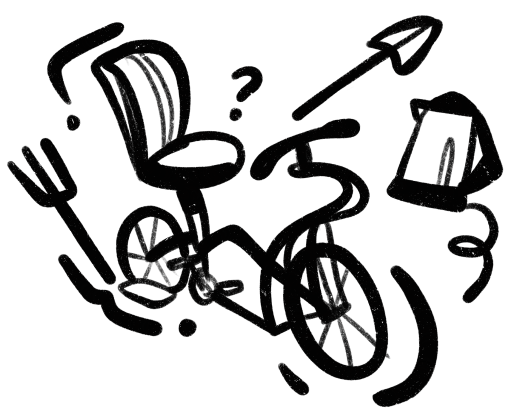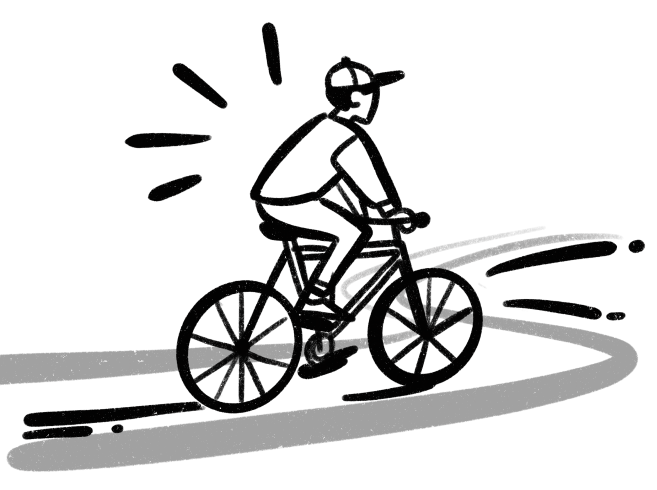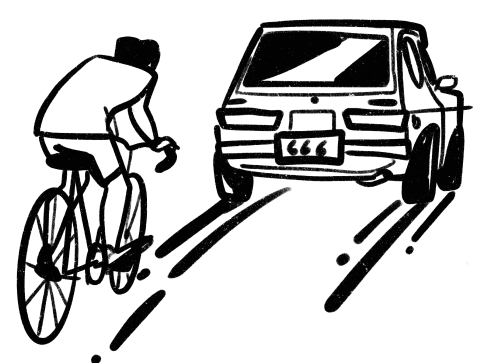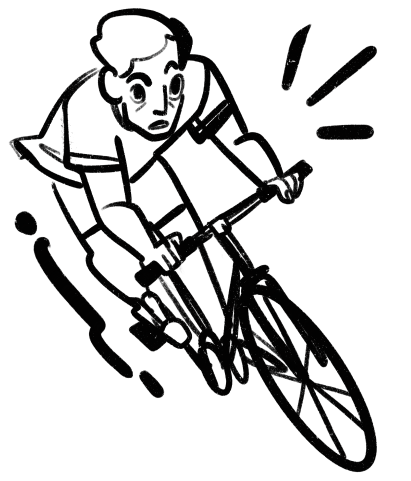How to invent a bicycle and not screw it up: tips and history
Instructions for those who dream of inventing a bicycle, but do not know where to start.
Disclaimer. The editors of The Global Technology magazine categorically insist that the article is for informational purposes only and does not recommend reading the hidden intentions in the middle of bicycle spokes.
If one morning you carefully examined your home and realized that the things familiar to everyone in your apartment have acquired a new meaning: a Christmas tree garland serves as an imitation of a thief repeller, a toothbrush faithfully serves you as a moisture insulator, a computer power supply willingly helps you out when needed charge the battery, and the copper wire is tied to the radiator for a reason, you can safely be called the “inventor of the bicycle.” If you have a burning desire to become a real creator of a real iron all-terrain vehicle, but don’t know where to start, this 9 key point plan will help you.
1. Visualize a bicycle in your mind and repeat the phrase out loud several times: “It is not the bicycle that is inventing me. I’m the one making it up.”
The future bicycle you invent must be powerful, daring and incredibly maneuverable. Look around. Perhaps an ordinary lemon will inspire you to create a new bicycle, and then we will see a new, super-bright and positive show-class bike that will decorate any city streets and highlight country roads.

Just imagine a lemon bike, in which the grips – the handlebar handles of the future lemon bike – are painted in a flashy orange color, pictures in the form of slices of lemons are pasted on the wheel spokes, the mirrors are made in the form of halves of citrus fruits, and the iron horse itself is decorated with a vintage analogue speedometer and stylish bright yellow lanterns.
It looks like you’re already drooling.
Keep imagining your future bike model. Perhaps an open fire will inspire you to give your future iron friend a unique appearance, and then your bike will have an open chain drive and a defiantly bright red color.
Perhaps, seeing your diligence in visualization, Deus Ex Machina himself will come down to you from heaven and advise you to make the steering wheel of your future bicycle in the form of lightning, and match the wings to the color of the heavenly clouds.
Visualize.
Maybe you will be inspired to make a new bicycle model by the heroes of your favorite comic books, and then your invention will have a removable portable audio system in the shape of your favorite hero.
If the visualization of a future invention catches you off guard, turn to friends for help, as Gianluca Gimini did. He invited his friends and acquaintances to draw an ordinary bicycle from memory. And although almost all the bicycles were depicted with obvious technical errors, Gianluca went further and created realistic 3D models from funny pictures to demonstrate how rich imagination people have, and then, based on those models, he made his own bicycle.
After successful visualization, start drawing.
2. Carefully inspect your home to see if there is a wheel in it that will meet the standards S = π × r2. Take a walk in the yard or do an unscheduled inspection of your or your neighbors’ garage.
You will need the wheel to assemble the bike. This is the basis. However, you don’t need to reinvent the wheel itself, because it was already invented about 6,000 years ago.
When the first villages of settled farmers appeared, the first crafts appeared and brave industrialists had no choice but to invent a potter’s wheel to sculpt pots. Then it was not yet a wheel, but something in the shape of a circle was already spinning around an axis, giving hope for a speedy invention.

Then, the same artisans decided to establish trade communications with other communities, using livestock to transport their goods, and then they invented the sleigh with runners. But it seemed irrational to industrialists who knew how to count to use the power of animals and sleds in a dry climate, and then the unknown inventor saw that same potter’s wheel. This is how the wheel appeared along with carts and animals that pulled them.
Once you find a wheel suitable for your future bicycle, look for the optimal elastic pair for it
3. Expand the geography of your search for other necessary parts for your future bicycle. Feel free to break the mold about what this simple transport should look like.
This is exactly what customizers do – the very guys who create one-off and exclusive bicycles, essentially reinventing them, using the most unexpected materials: chair backs, plastic cylinders, shovels, kettles and forks – of the latter, by the way, the customizers say, they make good saddles.

If your neighbor’s garage and yours don’t have any extra farm equipment, and the two wheels you found aren’t a bicycle yet, visit the city dump, and then go on a cross-country road trip.
4. Don’t be fooled by other people who will pretend to be those who invented the bicycle. Study history carefully.
The family tree of the bicycle is so branchy that it looks more like a bush, and the history of the invention of the bicycle goes back nearly two centuries.
The official history of the bicycle begins in 1818, when the German inventor Baron Karl von Drais received a patent for a “running machine” – Laufmaschine.
Karl von Drais was born in 1785 in the city of Karlsruhe and spent his entire adult life as a forester, but in all his free time when he was not protecting forests, the young baron was engaged in invention. First, Karl von Dres invented something like a small printing press for drawing lines on music paper, then a four-wheeled scooter, which turned out to be heavy, slow and very unreliable, and then the very “running machine” with which he made history.

Historians are still arguing, trying to establish exactly when it dawned on Karl von Drais to connect two wheels with a wooden frame, attach a steering wheel and a saddle to it, but it is known that in 1817, the Head of the Forestry Department accidentally saw his subordinate riding along the road on a strange two-wheeled structure, instead of working.
After that chance meeting, Karl von Drais suddenly lost everything – housing, work and money, but gained a lot of free time to do what he loved and improve his running machine. Within a couple of months, the inventor staged a demonstration run: he drove from Mainheim to Rheinau, covering 7 km in just an hour and reaching speeds of up to 14.5 km/h on some parts of the route.
The running machine created a real sensation. A little later, Karl von Drais received the honorary title of professor of mechanics for his invention and issued a privilege – an analogue of a modern patent. However, the privilege did not protect the inventor and his brainchild. Drais’s running machine rolled along the roads of Europe, England and even America without any license, and along the way it lost its name: Laufmaschine began to be called draisines – in honor of the inventor.
In 1840, the Scottish blacksmith Kirkpatrick Macmillan equipped the rear wheel of the Drais’s running machine with pedals. The connection was made using metal connecting rods. Another 20 years later, the young French inventor Pierre Lallement, who was making strollers, moved the pedals to the front wheel. In 1864, he also demonstrated an improved running machine to the Lyon industrialists – the Olivier brothers. They involved carriage engineer Pierre Michaud in the work, who replaced the wooden frame with a metal one and came up with a new name for the structure: “bicycle” – from two Latin words: velox – “fast” and pes – “leg”. Pierre Lallement patented the invention in America in 1866.
That same year, Briton James Starley invented and patented his version of a bicycle with a large front wheel and a small rear one. The design was called penny-farthing – from two English coins: a large penny and a small farthing. This bike was popularly nicknamed “spider”.
In 1868, French engineer Clément Ader received a patent for rubberized bicycle tires, and British engineer Edward Cowper created a metal spoked wheel.
In 1874, James Starley came up with a new way to spoke wheels – a tangential way. With this method, unlike the radial one, the spokes intersect and the wheel can withstand higher loads.
Over the next few years, various British inventors created several very important design additions: Thomas Brouwet and William Harrison invented rim brakes, Henry John Lawson added chain drives.
The bike lacked only pneumatic tires for its modern look. This simple and brilliant idea came not to an engineer, but to a veterinarian. In 1887, British veterinarian John Boyd Dunlop took pity on his young son, who was getting bruises from a hard bicycle saddle, and placed a garden hose filled with water on the rims of the wheels. The concept was good, the shock absorption was excellent, but the bike lost speed. It was needed to refine the idea – to replace water with air. That is how the nipple and pump appeared.
According to Chinese historians, the world’s first vehicle driven by human muscle power was built by the ancient Chinese inventor Lu Ban in the 5th century BC. This bicycle was built from bamboo and wood, so only its description survives. But the authenticity of these documents could not be proven.
Also, Leonardo da Vinci’s bicycle, invented by him in 1493, was preserved only in drawings. The authorship of the sketch, however, has not been confirmed.
According to German historians, the world’s first bicycle was built in 1685 by a watchmaker from Nuremberg, Stefan Farfler. But, actually, this hand-powered device had three wheels, and it was more a predecessor of the car than of the bicycle.
For a long time, French historians had their own version of the invention of the bicycle: it was allegedly designed in 1791 by the Comte de Sivrac. And for quite a long time, priority was left to him, until it turned out that the world’s first bicycle, together with the Comte, was invented by the French journalist Charles Louis Baudry, a passionate motorist and founder of the magazine “Means of Transportation.”
So, whatever one may say, the author of the most popular city vehicle is Baron Karl von Drais.
Don’t be fooled and move on to the assembly.
5. Be attentive to details. After properly assembling the bike, it is important to enter the cycling season correctly.
After you have assembled the bicycle you invented, gave it a test drive under the amazed glances of your neighbor, from whose garage you borrowed a couple of parts, open the cycling season according to all the rules of real cyclists:
– Wash the bike. Let your iron friend sparkle with cleanliness – this will make you both even more sexy!
– Check the tubes, tires, valves, steering wheel and, most importantly, the brakes – something might have broken down during the joyful demonstration of your invented design.

– Lube your bike: just like your facial skin, it needs regular care.
– Before going anywhere, be sure to dress warmly and preferably wear glasses – freshly thawed dust, the envy of pedestrians and especially persistent insects will fly into your eyes.
– When riding your new iron friend, be careful: during the invention of the bicycle, you might have accidentally forgotten about the recklessness of some drivers.
6. In order to become a real biker on any roads and belong to a biker community, learn a few terms by heart.
Knowing the terminology used by cyclists will help you avoid awkward situations:
– Hey, brother, what kind of trough did you invent? Will it survive a Bunny hop?
The bunny hop is a high jump.
Manual – driving on the rear wheel without pedaling.
One hand – taking one hand off the handlebars in the air.
Flip whip – spinning the bike in the air.
One foot – taking one foot off the pedal in the air.
No foot – taking both feet off the pedals in the air.

No-foot can-can – taking both feet off the pedals and throwing one over the frame.
X-up – turning the steering wheel 180 degrees without lifting your hands.
Backflip – backflipping with a bicycle.
Turndown – moving the frame to the side and unscrewing the X-up.
7. Take care of your safety and the safety of the bicycle you invented. Write down and remember all the important signs that will provide you with super-easy passage of any route.
If while driving you see a car with number 666 in front of you, look in the rearview mirror three times and trouble will pass you by.
If you don’t put on bicycle fenders before leaving,
it will rain.
If you forget the pump, you will puncture the tire.
A policeman at the side of the road means unnecessary trouble.

8. Learn to see in the dark, develop occipital vision, master the skill of seeing obstacles with your skin.
Find the differences.


9. While riding your newly invented bicycle, remember an anecdote or funny incident from your life.
One car enthusiast is driving home from work in his Mini Cooper, and then a cyclist overtakes him. The motorist accelerated, but the cyclist overtook him again. The car enthusiast stepped up the gas again, looked in the rearview mirror, and there a cyclist with a scary expression on his face was pedaling and overtaking him.
That happened several times. In the end, the car enthusiast could not stand it and cut off the cyclist at a turn, got out of the car and began to swear:
– Hey you, did you believe in yourself?
To which the cyclist answers:
– No! I just caught my suspenders on your mirror.

We’ve ventured beyond the boundaries of time and space. By the way, it’s empty there.
Thank you!




